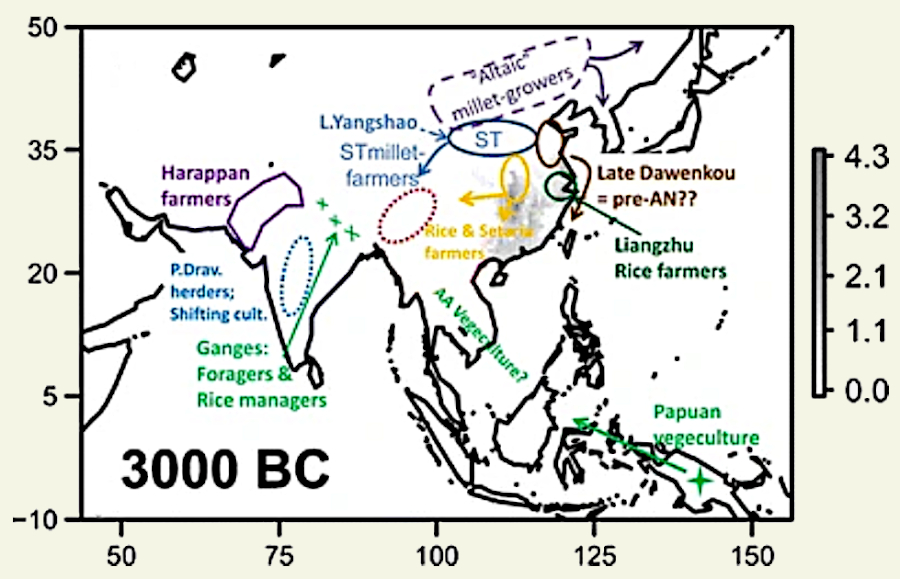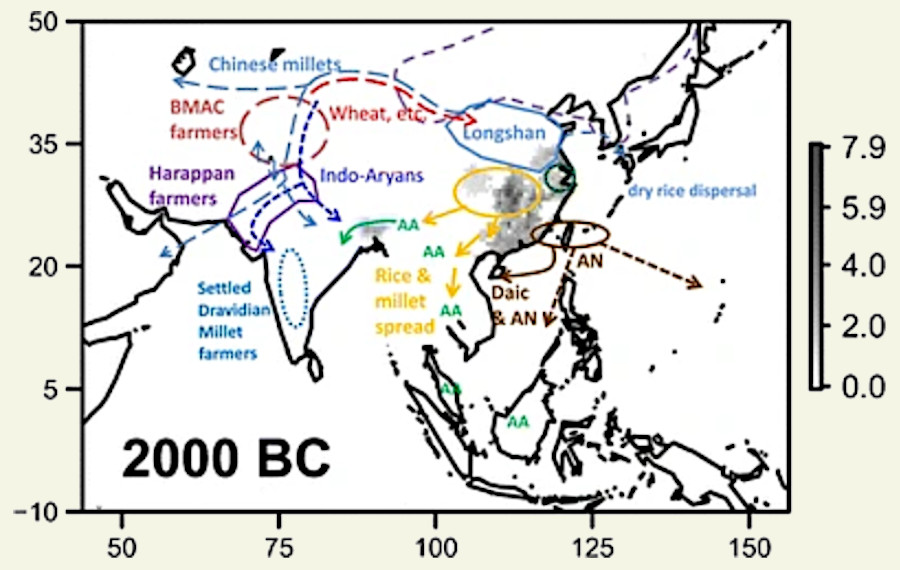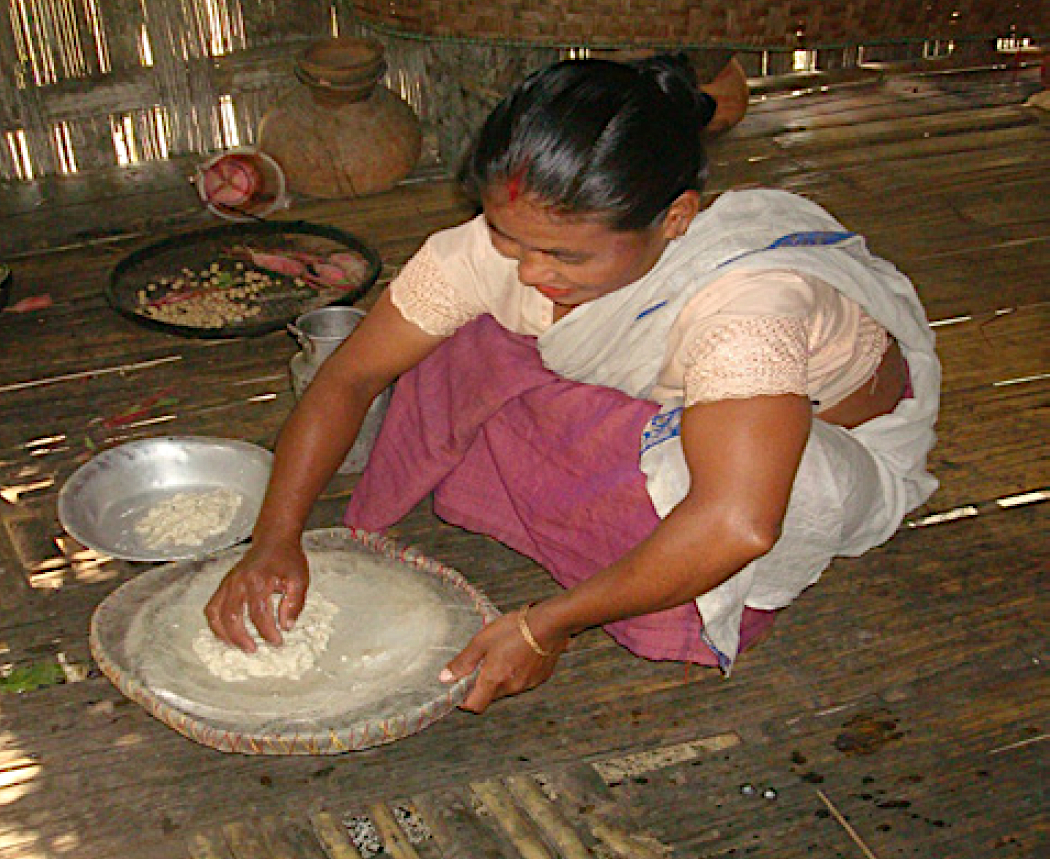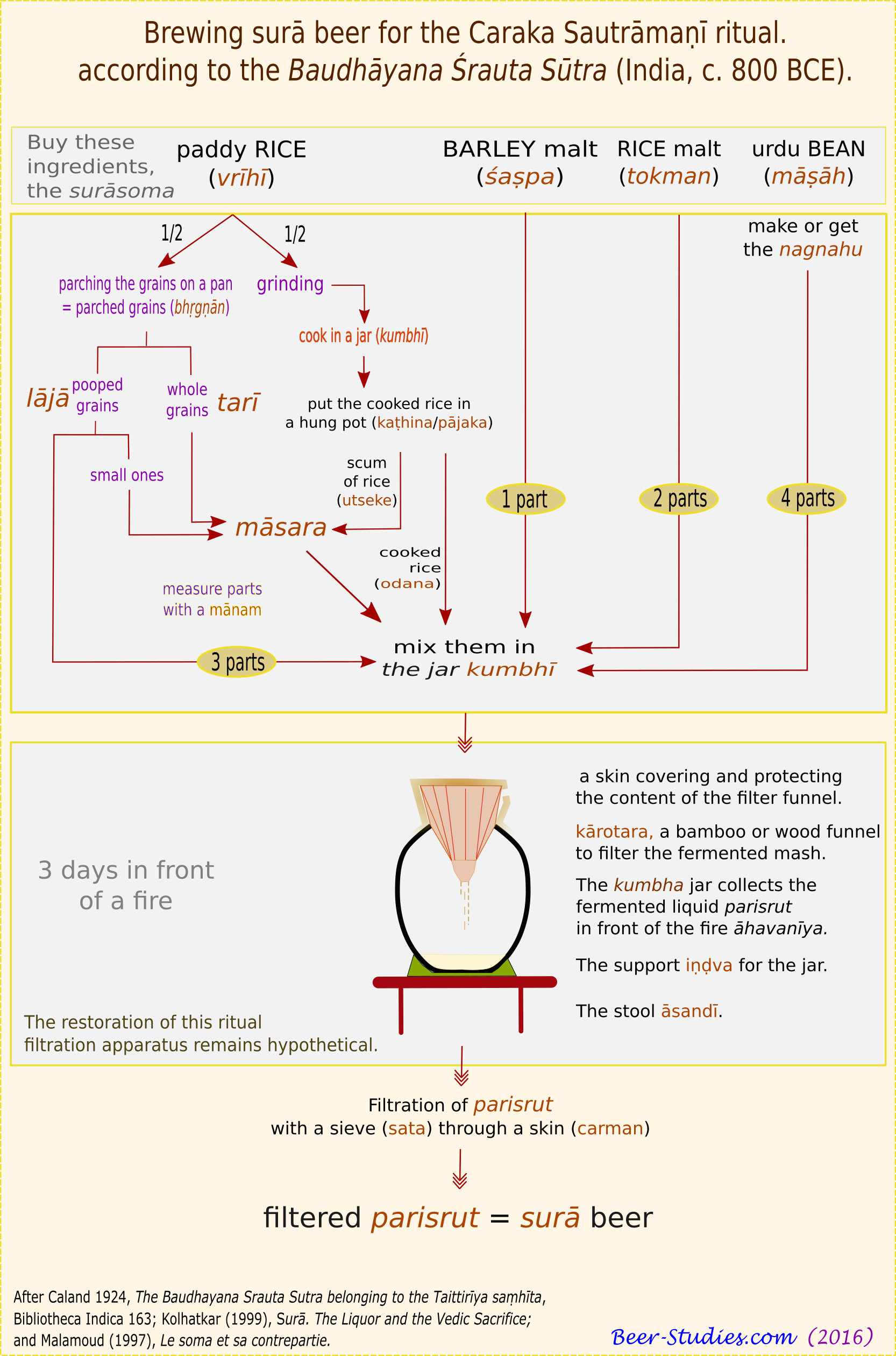The technical diagrams for brewing the surā beer.
The Vedic texts provide fairly detailed explanations about the methods of brewing surā beer, the ingredients and equipment used. We can infer general technical schemes from these. It should be borne in mind that they are implemented in the highly ritualised context of sacrifices. These explanations and comments were written to ensure the proper performance and success of the rituals. They prescribe technical gestures that are both complex and very specific.
This accuracy not only restores 3,000-year-old brewing patterns, but also proves once and for all that the surā beverage is technically a beer. The expression surā-beer is justified by the Vedic texts themselves. The surā of Vedic times is neither a wine, nor a liquor (a fuzzy generic term), nor a distilled spirit!
These texts were studied and published as early as the 1850s by eminent European Indianists without the term 'beer' ever being written[1]. For which reasons? We see two main explanations. Linking the very prestigious Vedic civilisation with a drink as 'popular' as beer was not appropriate. And to give beer - understood as a Western drink - a geography extending to India was not conceivable at that time. Both of these reasons are still valid among historians. The historical definition of beer remains trapped in a Western myopia. Beer is said to be the fermented beverage that the Western brewing industry calls "beer" (a drink made from barley, water and hops). This tautological definition is untenable for a global history of beer, whose geographical and chronological boundaries stretch far beyond Western Europe. See general technical definition of beer
We need to go through the technical brewing diagrams to show that other cultures, other peoples, other civilisations have been able to brew fermented beverages that are technically beers albeit not like modern-day western beer. This general understanding requires a technical definition of beer. Beer = a saccharified and fermented starch-based beverage. surā beer conforms to this technical definition of beer. It is a fermented beverage made from rice (raw or malted), barley (raw or malted) and millet.
By brewing scheme we mean a set of technical operations, ingredients and quantities described in sufficient detail for the recipe or process to be reproduced today. This is the case for the two diagrams below, with one caveat: the preparation of nagnahu amylolytic ferments is not described. The list of plants used in their preparation is not given. These plants provide either the enzyme complexes or the moulds able to saccharify the starch and, secondarily, to induce the alcoholic fermentation.
The first diagram for brewing surā-beer is drawn from the Baudhāyana Śrauta Sūtra, a text describing the Caraka Sautrāmaṇī ritual. This document is dated to c. 800 BCE.[2].
The second scheme for brewing the surā-beer is given by the Āpastamba Śrauta Sūtra, a text that describes the Kaukilī Sautrāmaṇī ritual of fire offerings (Śrauta). This document is dated to c. 500-300 BCE.
The brewing of surā beer described in these Vedic texts is not the same as recipes for brewing ordinary surā beer, the kind drunk by warriors (Kshatriyas), craftspeople (Vaishyas) or farmers (Shudras). But we know that the sacrificers, leaders or sponsors of the rituals relied on technicians and sellers to get the ingredients for brewing: raw grains, malt, beer ferments. The technical know-how to brew beer was in the hands of beer specialists, professional brewers (surākāra), beer sellers or tavern keepers. The know-how of the Brahmins carrying out the rituals concerned the correct memorization and recitation of the mantras, as well as the deep religious knowledge of the rituals and their reasons for being. Brewing techniques belong to the 'secular' world and not the other way round. These brewing techniques, like other related food techniques (pottery, tools making, plant processing, etc.), were highly ritualised by Brahmins, but their technical implementation resorts to the normal and widespread beer brewing in India at that time.
How does one manage to derive a brewing scheme from a text describing the codified course of a Vedic ritual? By removing all the symbolic prescriptions from the text and retaining only the relevant technical data on the preparation of a fermented beverage. Whatever the context of brewing, the biological and biochemical constraints are identical, today as they were 3000 years ago.
These two brewing patterns are the oldest known to date, it should be noted, with the exception of a Mesopotamian brewing pattern that can be reconstructed with the text of the Hymn to Ninkasi dating from c. 1800[3]. Egyptian brewing patterns are still very hypothetical and based on mastabas frescoes, visual representations almost devoid of technical textual data[4]. The Egyptian brewing ratios (pefsu = vol. grains/vol. beer) from the Middle Kingdom (2065-1735 BCE) are general arithmetic formulas that do not give any technical details on how to brew beer. The Chinese brewing techniques are documented by more recent texts (Ch'i min yao shu, c. 500). Documents depicting the European brewing patterns are also more recent (carolingian period 8-9th century). The technical data on beer brewing in Africa (except for ancient Egypt) or America are even more recent.
The main insight given by these ancient Indian brewing schemes is the duality of starch saccharification techniques: they use both the malting of paddy rice (tokma) or barley (śaṣpa), and the amylolytic ferments (nagnahu).
The Baudhāyana Śrauta Sūtra (BŚS 17.31) sheds light on the nature of these brewing ingredients. "tokmāṇi ca" refers to sprouted (paddy) rice, "śaṣpāṇi ca" to sprouted barley, nagnahuṃ cūrṇakṛtaṃ refers to the powdered nagnahu, a dry and crumbly ingredient. The text also refers to this nagnahu with the term pādakiṇvā. This is the earliest mention of the beer ferment kiṇvā (BŚS 26.22 v. 303-304), the making of which is described later in the Arthashastra. In both cases, the urad bean (māṣāḥ) serves as the starchy substrate. The Arthashastra additionally lists herbs, without specifying which ones, that go into the making of kiṇvā. The BŚS identifies kiṇvā with nagnahu but also with sprouted rice and sprouted barley:
"The surā for the Sautrāmaṇī [sacrifice] is a quarter kiṇva (pādakiṇvā) or a fifth. Śaṣpa and tokman, śaṣpa is of barley, tokman is of rice, nagnahu is urad lentils (māṣāḥ). Then the kārotara should be made of wood or of split bamboo (vaidala) or clay (mṛdmaya), and it should be covered with hide (carman) on all sides." [5].
According to this text, one would brew on the one hand with the agents for turning starch into sugars (nagnahu + germinated rice + germinated barley) accounting all for 1/5 or 1/4 of the volume (or weight) of the raw materials for brewing the surā beer, and on the other hand with the cooked rice (vrīhī) providing the main mass of starch, by inference 4/5 or 3/4 of the total initial volume of raw brewing materials (see beer brewing pattern no. 1).
Barley and wheat cultivation spread eastwards from western Asia (Fertile Crescent, Iran, Afghanistan). It was adopted in the Indus Valley between 3000 and 2500 BC, and in northern India between 2500 and 1500 BC. The domestication of Indian rice (Oryza sativa subsp. indica) with the sedentarisation of the populations follows instead an East (Assam) => westward route along the Ganges valley and starts between 1850 and 1500 BC. The millets are indigenous Indian crops (small Indian millet (Panicum sumatrense), yellow foxtail (Setaria pumila), Brachiaria (Brachiaria ramosa) and barnyard grass (Echinochloa frumentacea))[6].
| Diffusion of cereals in India. Barley and wheat come from the west and are adopted in the Indus Valley around 2500 BC. Indica rice (paddy field cultivation) comes from the east through Assam around 3000 BC and spreads along the Ganges valley around -2000 BC. | |
 Diffusion of wheat and barley from Western Asia to the Indian subcontinent (Stevens & al. 2016 fig. 2.) Diffusion of wheat and barley from Western Asia to the Indian subcontinent (Stevens & al. 2016 fig. 2.) |
|
 Subsistence cultures and language affiliation for ca. 3000 BC, AA Austroasiatic, AN Austronesian, P.Drav. Proto-Dravidian, ST Sino-Tibetan. (Fuller D. 2011, Pathways to Asian Civilizations: Tracing the Origins and Spread of Rice and Rice Cultures)[7]. Subsistence cultures and language affiliation for ca. 3000 BC, AA Austroasiatic, AN Austronesian, P.Drav. Proto-Dravidian, ST Sino-Tibetan. (Fuller D. 2011, Pathways to Asian Civilizations: Tracing the Origins and Spread of Rice and Rice Cultures)[7]. |
 Subsistence cultures and language affiliation for ca. 2000 BC, AA Austroasiatic, AN Austronesian, P.Drav. Proto-Dravidian, ST Sino-Tibetan. (Fuller D. 2011, Pathways to Asian Civilizations: Tracing the Origins and Spread of Rice and Rice Cultures) Subsistence cultures and language affiliation for ca. 2000 BC, AA Austroasiatic, AN Austronesian, P.Drav. Proto-Dravidian, ST Sino-Tibetan. (Fuller D. 2011, Pathways to Asian Civilizations: Tracing the Origins and Spread of Rice and Rice Cultures) |
The old Indian beer brewing patterns reflect these two opposing diffusions of barley and rice. At the time of writing (800-500 BC), barley and rice had been already cultivated throughout northern India for 1-2 millennia. The malting technique is based on cereals such as barley, wheat or millet. The amylolytic fermenting technique is linked to rice cultivation in more recent times. However, the Indian brewing schemes proceed with the malting of paddy rice. This technique bears the traces of an earlier time when barley malting inspired paddy rice malting in the Ganges valley.
Strangely enough, the use of amylolytic ferments should dispense with malting, and vice versa for malting in relation to amylolytic ferments. They both perform the same function: the proper saccharification of the starch. However, brewing schemes use malting and brewing ferments together. It seems that the rituals involving brewing surā beer functioned as repositories of ancient techniques, all of which were preserved and updated over the course of sacrifices, hence the relative complexity of the brewing methods and their seemingly redundant techniques.
It is questionable whether the normal brewing of surā beer followed such complex methods. The choice between malting and fermenting beer must have been more definitive in producing surā beers of various kinds in the regions of ancient India. A later text contemporary with the Maurya Empire (322-185 BCE) lists common beers, provides their composition, and now speaks only of brewing ferments (kinva). The malting technique, without having disappeared, seems to have been marginalised (List and composition of beers in the Maurya empire).
|
Brewing of traditional rice beers in Assam and Nagaland (North East India). Some beer ferments and filtration operations of the fermented mash to extract the beer. After Das, Deka, Miyaji, 2012, Methodology of rice beer preparation and various plant materials used in starter culture preparation by some tribal communities of North-East India. A survey . www.ifrj.upm.edu.my/19%20(01)%202011/(14)IFRJ-2011-137%20Deka.pdf, and Pegu R. et al. 2013, Apong, an alcoholic beverage of cultural significance of the Mising community of Northeast India . longdom.org/articles/apong-an-alcoholic-beverage-of-cultural-significance... |
||
-1.jpg) -3.jpg) .jpg) |
   |
.jpg) .jpg)  |
| Various types of beer ferments made in the north-east of India. The plants used in their composition vary infinitely. | Fermented rice mash (Zutho) in Nagaland awaiting dilution and filtration. Filtration of the fermented mass with a cloth. | Filtration of the fermented mash with a bamboo filter. Zutho beer (Nagaland, North East India) served in bamboo cups. |
[1] For example, as early as 1868 Albrecht Weber described the brewing of the surā drink for the Sautrâmaņi ritual (Weber 1868, Indischen Studien 10, 349-351), although he did not describe it as 'beer'. For recent studies of surā-beer, although the term 'beer' is rarely used : Prakash 1961, Food and Drinks In Ancient India. From Earliest Times To B.C. 1200 A.D. ; Malamoud 1991, Le soma et sa contrepartie. Remarques sur les stupéfiants et les spiritueux dans les rites de l’Inde ancienne; Kolhatkar 1999, Surā, the Liquor and the Vedic Sacrifice; Oort 2002, Surā in the Paippalāda Saṃhitā of the Atharvaveda; Roy 2015, Fermentation technology, in Bag 2015 History Of Technology in India vol. I, 437-447.
[2] The dating of Vedic texts is a complex issue. Indianists propose relative chronologies of the texts based on their linguistic developments, their internal references (such and such a text mentions such and such a supposedly earlier text), and their rare external references to datable historical facts for the most recent periods. The dates proposed for the Baudhāyana Śrauta Sūtra and the Āpastamba Śrauta Sūtra remain conjectural. Both texts belong with certainty to the Brahamanas tradition (900-500 BC). The second is probably later.
[3] There are many obscurities in the Hymn to Ninkasi, especially the nature and technical role of BAPPIR. It is not enough to brew with emmer wheat or add date syrup to claim that one is brewing a 'Mesopotamian beer'.
[4] The often quoted text attributed to Zosimus of Panopolis (3rd-4th century) describes the brewing of Zuthos beer, more precisely the malting of grains. It may be a later apocrypha.
[5] Caland Willem, The Baudhayana Srauta Sutra belonging to the Taittirīya saṃhīta, ed. W. Caland, Bibliotheca Indica 163, Calcutta: Asiatic Society of Bengal, 1904-1924, New Delhi. Trad. Mc Hugh 2021, The Ancient Indian Alcoholic Drink Called Surā: Vedic Evidence, Journal of the American Oriental Society, Vol. 141, No. 1, 56.
[6] Stevens & al., Between China and South Asia: A Middle Asian corridor of crop dispersal and agricultural innovation in the Bronze Age, The Holocene 2016, Vol. 26(10) 1541–1555. pubmed.ncbi.nlm.nih.gov/27942165/
[7] The growing of wild and domesticated rice varieties, its protohistory in the Indian subcontinent, and the relationship with rice domestication in southern China, is a complex and much debated issue. Dorian Fuller presented a synthesis in 2011 (Pathways to Asian Civilizations: Tracing the Origins and Spread of Rice and Rice Cultures. www.researchgate.net/publication/257778513_...). Around 3000 BC, wild rice varieties Aus and Indica are collected in northern and southern India by hunter-gather peoples (protodomestication). Around 2000 BC, the domesticated rice Oryza sativa subsp. japonica reached eastern India and hybridised with Oryza sativa subsp. indica, leading to irrigated rice cultivation in the Ganges Valley.





